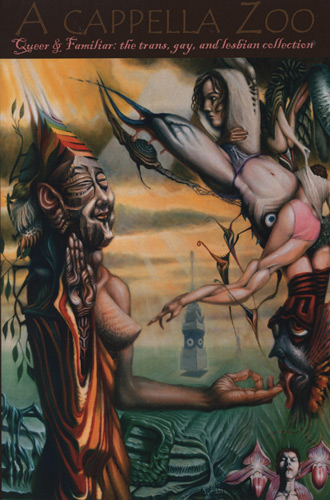A Cappella Zoo – Fall 2015
A Cappella Zoo, a journal of magical realism, dedicated its 15th issue to queer stories. Though titled Queer & Familiar, rather than creating a queer and familiar text, A Cappella Zoo creates a work that queers the familiar, capitalizing on the opportunities in magical realism. This collection makes queerness familiar. A Cappella Zoo, a journal of magical realism, dedicated its 15th issue to queer stories. Though titled Queer & Familiar, rather than creating a queer and familiar text, A Cappella Zoo creates a work that queers the familiar, capitalizing on the opportunities in magical realism. This collection makes queerness familiar.
It’s ironic that the collection begins on shaky ground with “Orlando-bound,” a fiction piece by Wayne Bachner. When the Earth’s magnet poles flip, everyone gradually becomes a different sex and gender. Bachner begins the story as a mystery, providing details that there have been “at least twenty-two million suicides” but without providing an explanation. On one level, Bachner’s story legitimizes the mental health concerns within the trans community by placing everyone in the role of feeling out of place in your own body. However, the story rides the gender binary train: if you’re male you become female, if you’re female you become male. The story falls short because Bachner fails to acknowledge the multiplicity of genders and sexes.
Bonnie Jo Stufflebeam’s “The Centaur’s Daughter” achieves a more nuanced approach to a queer text. First and foremost a coming of age narrative, Ruby’s queerness is one part of her character. Ruby is half centaur and queer, and Stufflebeam uses language reminiscent of a mixed-race family to discuss Ruby’s parentage. When Ruby narrates, “I’m a combination of my parents, and so they will never understand me,” she speaks from a place of real cultural confusion. Her teenage life is not like the “Centaursploitation movies” Stufflebeam references, and while Ruby loves her centaur father, she is also frightened of him and embarrassed by him. Stufflebeam’s piece makes queerness familiar because Ruby is a queer character, but she is so much more in ways that are both relatable and strange.
“The End of Objects” by Jack Kaulfus reimagines the afterlife as a place of crucial decisions. Who will you return to Earth as, and what objects will you leave your reincarnated self? What legacy you will pass down? For Mirelle, who she’ll return to Earth as is obvious when given the choice: female. Kaulfus introduces Mirelle as female before introducing her as a trans woman. Although “Mirelle was originally the son of a speed-addled mother and philanderer of a father,” male pronouns always feel incorrect. This same sense of misplacement in the afterlife establishes a parallel narrative. Mirelle journeys in the afterlife for objects to give to her reincarnated self, and all the while, she journeys through memories of coming to consciousness of her trans identity. As a warning, Kaulfus writes a violent transphobic and homophobic scene. But it is that very violence set against a calm afterlife that invigorates this queer take on reincarnation and the way we learn Mirelle’s past and future.
Victorya Chase brings life to the fairytale in “Dreaming of the Manananggal.” The Manananggal, a female horror figure who can split her body at the waist, is a creature of Filipino folklore. Chase utilizes this monster to transform a negative depiction of lesbianism—the Manananggal sucks fetuses out of the womb with her tongue—into a positive creature of healing and understanding. Mourning the death of her lover Jennie to cancer, the narrator kidnaps a Manananggal. The Manananggal comes to represent connection between the narrator and Jennie, as well as the narrator and her mother. Jennie “asked me to tell her stories about [ . . . ] my family. I told her fairy tales instead.” Fairytales become the language of love between women as Chase queers our understanding of fairytales and how we heal.
In the final piece in the collection, Javier Flores and Theo Zedek have a loving relationship. But after fifteen years, Javier Flores must once again become node AR1x40: a part of an alien collective-consciousness known as the Commonality. Bernard M. Cox’s “La Chanson de l’Observation” is told as an analytical report studying human relationships. Opening with a Preface, then Method and Results, Cox writes two simultaneous voices: the first person plural of the Commonality, and the first person of Javier/node AR1x40 as he develops a singular consciousness. The shift in perspective allows Javier to say, “Theo smells of fresh bread, and his lips taste of chocolate,” and then the Commonality to say, “This experiment is a longitudinal study in fifteen year increments.” Both are honest, fleshed out voices, accepting of queer identities. Cox familiarizes us with Javier’s queer relationship and defamiliarizes us to human culture.
A Cappella Zoo publishes an issue where queer characters are everywhere. Accepted, or not, in their fictional worlds, queerness exists and is legitimized. Despite a few bumps, the issue does what it promises and more. By pairing queer characters with magical realism, the collection normalizes queerness as another fact in an already bizarre world.
[www.acappellazoo.com]





